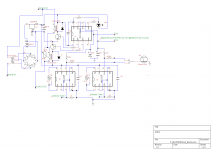Hi Matt BH,
I thought I had read somewhere that it is "best practice" to keep the meter out of the circuit for general use, only inserting it when checking the bias.
If it doesn't matter, I'll skip the bypass.
I thought I had read somewhere that it is "best practice" to keep the meter out of the circuit for general use, only inserting it when checking the bias.
If it doesn't matter, I'll skip the bypass.
Maybe someone thought it has some form of non linear resistance like a fuse that really does.
Nah, leave it in circuit. You could always try some blind A/B testing with your friends but I really don't think anyone or any measurements will tell a difference. That is as long as the wiring isn't six feet long🙂
Cheers
Matt
Nah, leave it in circuit. You could always try some blind A/B testing with your friends but I really don't think anyone or any measurements will tell a difference. That is as long as the wiring isn't six feet long🙂
Cheers
Matt
Just for info, I have a rather nice GE(UK) meter with the UK's government crows foot stamp on the scale that I inherited from my grandfather. It is a 25uA movement! Pretty impressive. It was new in its box. The terminals were shorted with a wire wound round them for postage/shipping but it also has two back to back germanium diodes across the terminals. I would date it around 1955-6. The diodes protect the movement from excessive voltage. Funny thing is that when the movement is returning to zero it generates enough back EMF to turn on one of the diodes. The movement returns to zero really slowly. Possibly has thousands of turns of wire way, way thinner than a blonde one.
Cheers
Matt
Cheers
Matt
Last edited:
- Status
- Not open for further replies.
